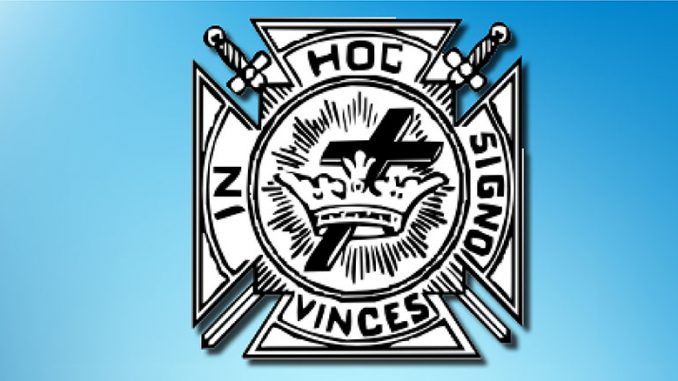
“In Hoc Signo Vinces,” Latin for “In this sign, you shall conquer,” is a phrase with historical significance that has been associated with Christianity and the Knights Templar. The origin of this motto can be traced back to the legend of Emperor Constantine the Great, who ruled the Roman Empire in the early 4th century.
According to the legend, as Constantine prepared for a decisive battle against his rival Maxentius in the year 312 AD, he witnessed a miraculous vision in the sky. Some accounts describe it as a dream or vision, while others assert that Constantine saw the sun with a cross of light above it, along with the inscription “In Hoc Signo Vinces.” This celestial spectacle was interpreted as a divine message and an omen of victory.
Taking the sign as a divine mandate, Constantine embraced Christianity and adopted the cross as his symbol. On the following day, he had a banner made, known as the labarum, featuring the monogram of Christ, a combination of the Greek letters “rho” (P) and “chi” (X), forming the first two letters of Christ’s name in Greek. This banner became Constantine’s imperial standard and was carried into battle, signifying his allegiance to Christianity and belief in its protective power.
The phrase “In Hoc Signo Vinces” became synonymous with Constantine’s conversion and his ultimate triumph over Maxentius at the Battle of the Milvian Bridge, a victory that secured his position as the sole ruler of the Western Roman Empire. As a result, Christianity gained official recognition and became a favored religion within the Roman Empire, a significant turning point in history.
The connection between the motto and the Knights Templar is more complex. While some historical accounts suggest that the Templars used “In Hoc Signo Vinces” as their motto, there is limited concrete evidence to support this claim. The Knights Templar, a medieval Christian military order, did have their distinctive black and white banner, the Beauseant, with the Latin inscription “Non nobis Domine, non nobis, sed nomini to da gloriam” (Not unto us, O Lord, not unto us, but unto Thee give the glory). This was their battle cry and symbol of their dedication to God’s glory.
Over time, the motto “In Hoc Signo Vinces” has become a symbol of determination, faith, and divine support. It continues to be referenced in various contexts, often serving as a reminder of the power of faith and the belief in a higher purpose. Whether on flags, coat of arms, or in literature, the phrase remains a testament to the enduring impact of faith and the courage to face challenges with unwavering resolve.
Here is what Albert G. Mackey had to say on the motto in The Symbolism of the Cross and the Grand Masonic Emblem of the Compass and Square”
“On the Grand Standard of a Commandery of Knights Templar these words are inscribed over “a blood-red Passion Cross,” and they constitute in part the motto of the American branch of the Order. Their meaning, “By this sign thou shalt conquer,” is a substantial, but not literal, translation of the original Greek.
“For the origin of the motto, we must go back to a well known legend of the Church, which has, however, found more doubters than believers among the learned. Eusebius, who wrote a life of Constantine says that while the emperor was in Gaul, in the year 312, preparing for war with his rival, Maxentius, about the middle hours of the day, as the sun began to verge toward its setting, he saw in the heavens with his own eyes, the sun surmounted with the trophy of the cross, which was composed of light, and a legend annexed, which said “by this conquer.”
“This account Eusebius affirms to be in the words of Constantine. Lactantius, who places the occurrence at a later date and on the eve of a battle with Maxentius, in which the latter was defeated, relates it not as an actual occurrence, but as a dream or vision; and this is now the generally received opinion of those who do not deem the whole legend a fabrication.
“On the next day Constantine had an image of this cross made into a banner, called the labarum, which he ever afterward used as the imperial standard. Eusebius describes it very fully. It was not a Passion Cross, such as is now used on the modern Templar standard, but the monogram of Christ. The shaft was a very long spear.
“On the toll was a crown composed of Gold and precious stones, and containing the sacred symbol, namely, the Greek letter “rho” or P. intersected by the “chi” or X, which two letters are the first and second of the name “XPISTOS”, or Christ.
“If, then, the Templars retain the motto on their banner, they should, for the sake of historical accuracy, discard the Passion Cross, and replace it with the Constantinian Chronogram, or Cross of the Labarum. But the truth is that the ancient Templars used neither the Passion Cross, nor that of Constantine, nor was the motto “In Hoc Signo Winces” on their standard.
“Their only banner was the black and white Beauseant, and at the bottom of it was inscribed their motto, also in Latin, “Non nobis Domine, non nobis, sed nomini to da gloriam,” meaning “Not unto us, O Lord, not unto us, but unto Thee give the glory.” This was the song or shout of victory sung by the Templars when triumphant in battle.”
About Us
TemplarHistory.com was started in the fall of 1997 by Stephen Dafoe, a Canadian author who has written several books on the Templars and related subjects.
Read more from our Modern Templars Archives – Templar History



